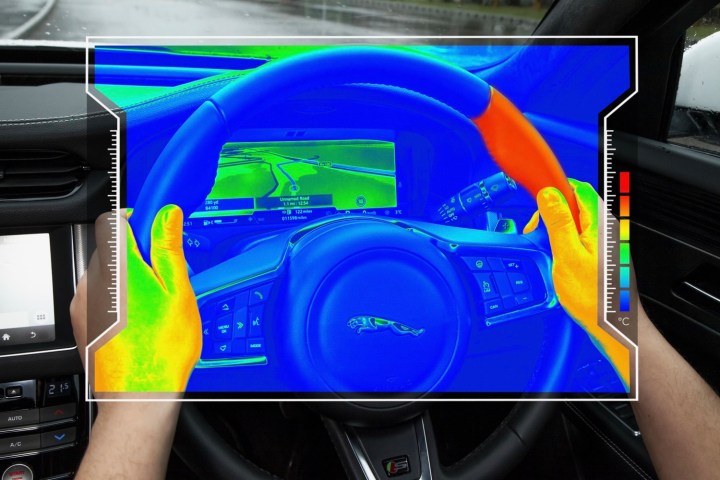
Modern cars have lots of built-in distractions. Elaborate touchscreen infotainment systems, digital gauge clusters, and head-up displays all try to give the driver information, but they also require drivers to take their eyes off the road. Jaguar Land Rover (JLR) is trying to combat the problem with what it calls a “sensory steering wheel.” By heating or cooling the wheel, JLR claims it can give turn-by-turn directions without forcing a driver to look away from the road.
Developed in partnership with Glasgow University, the steering wheel’s temperature can be changed from hot to cold by up to 6 degrees Celsius (42.8 degrees Fahrenheit). By heating one side and not the other, the steering wheel tells drivers when to turn left or right, according to JLR. Temperature changes can also be used to tell drivers when to change lanes, or provide advance warning when approaching an intersection, according to the automaker. In possible future self-driving cars, the paddle shifters could be heated or cooled to indicate when the handover between human driver and autonomous system is complete, JLR said. The automaker has conducted limited autonomous-driving tests, and plans to supply the Jaguar I-Pace electric SUV to Waymo.
The tech was designed to cut down on distraction, but JLR noted that it could also be useful in reduced visibility, or for drivers who are unfamiliar with the layout of a given road. Temperature changes are perfect for navigation, JLR claims, because they aren’t as jarring as vibrations, or as disruptive as audio cues. The latter allows drivers to keep their eyes on the road, but no one likes having a conversation or a favorite song interrupted with a call to make a slight left in 100 yards.
The “sensory steering wheel” is just a research project with no immediate production prospects, but it’s another example of outside-the-box thinking from JLR. The British automaker has made a habit of approaching automotive tech problems from unusual angles. It previously attached giant eyes to a vehicle to see how pedestrians interact with self-driving cars, and used that research to create a language autonomous cars can use to “talk” to pedestrians. The automaker also created a scheme to pay drivers for reporting potholes and traffic jams.
Editors' Recommendations
- Watch this new lunar rover take a test drive in an otherworldly desert
- GM requests green light to ditch steering wheel in its self-driving cars
- Land Rover searches for ways to keep customers and regulators satisfied
- Exclusive: How Land Rover’s designers resurrected the Defender
- Redesigned Land Rover Defender is positively teeming with new tech


